Iceland’s glaciers - your ultimate guide
22. júlí 2022
Iceland’s glaciers - your ultimate guide
22. júlí 2022
An old joke says Iceland is green and Greenland is covered in ice. But a huge section of Iceland’s landmass is covered in glacial ice. Flopping like great white tongues through mountain ravines and stretching across volcanoes, Iceland’s glaciers are a sight to behold, either from a roadside lookout point, from the seat of a snowmobile or by embarking on a glacial hike. Glacier tours in Iceland let you get up close and personal with these magnificent geological wonders and a guided tour means you can learn about their creation and history. You can even experience the ethereal blue world of a glacial ice cave. However you want to discover glaciers in Iceland, Reykjavik Excursions has a range of tours to suit all kinds of traveller, and we’ve got the ultimate guide to Iceland’s glaciers to prepare you.
What is a glacier?
Glaciers are created over thousands of years as fallen snow turns into a huge mass of ice, usually in the valley of a mountain or (often in Iceland’s case) volcano. You may not be able to see it, but glaciers actually move. They inch very very slowly forward, like a super slow-motion river. You might hear cracks and creaks as the mass of ice shapeshifts, creating holes and crevasses, and even beautiful ice caves.
Most of the world’s glaciers are found in the Arctic regions and were formed in the last Ice Age. Iceland’s volcanic landscape is plugged with these glaciers and ice caps, which you can easily explore in person. How many glaciers are in Iceland? There are precisely 269 named glaciers in Iceland, which is a lot for such a small land mass. Altogether, Iceland’s glaciers make up about 11% of the entire country. Vatnajökull is an ice cap atop a volcano and is the largest glacial area in Iceland. It was awarded National Park status in 2008 and covers a whopping 4,141 square kilometres (about 14% of Iceland).
How old are glaciers in Iceland?
Some of Iceland’s glaciers were first formed thousands of years ago. Take Vatnajökull for example, which was formed 2,500 years ago. The ice started out as a cap on top of a volcano, and it wasn’t until the 13th century that the ice started to expand before culminating in the huge mass of glacier it is today in the 19th century.
Between 1890 and 1920, Iceland saw its own mini-Ice Age when glaciers expanded rapidly, before retreating as the climate warmed in the 1930s. Then, another cool period in the 1960s allowed Iceland’s glaciers to expand again, before another warming in the 1980s. So you can see Iceland’s glaciers wax and wane like the moon, depending on the climate.
Where are glaciers in Iceland?
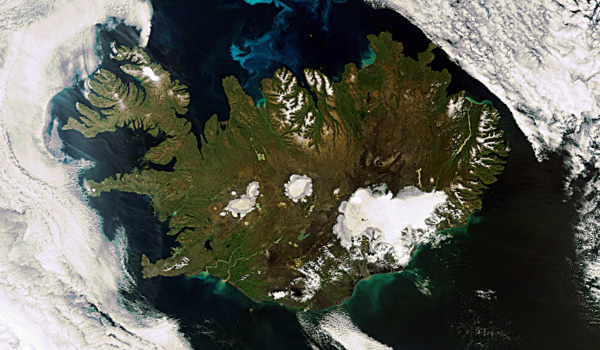
Iceland’s most famous glacier is probably Vatnajökull. It stretches over around 8,300 square kilometres and is around 900 metres at its thickest point. It’s the largest glacier in Iceland (and Europe in fact) and can be found in the southeast of the island. Huge white tongues spill through the mountain valleys from a central point and each of these off-shoots has been named. The most famous tongues are probably Öræfajökull, sitting atop the Öræfajökull volcano, and Svínafellsjökull which is a popular spot for glacier hiking as it’s close to Skaftafell. Svínafellsjökull has been used as a filming location for Interstellar and Batman Begins.
The second biggest glacier in Iceland is Langjökull, which literally means “long glacier”. In the heart of the Golden Circle tour circuit, this is a popular place to visit for snowmobiling. It’s about 50 kilometres long and around 580 metres deep at its thickest point. One of Langjökull’s biggest pulls is that it contains a manmade ice cave, which is accessible all year round, even when most other ice caves are closed in summer.
Famous for a completely different reason, the Eyjafjallajökull glacier can be spotted from the ring road around Iceland. It’s quite small, but no less impressive. Perhaps the most memorable thing about Eyjafjallajökull is the volcanic eruption in 2010 which caused an ash cloud and grounded thousands of planes across the world. You can spot this glacier from the roadside, or embark on a snowmobiling tour or 4x4 adventure if you want to get closer.
How to see glaciers in Iceland?
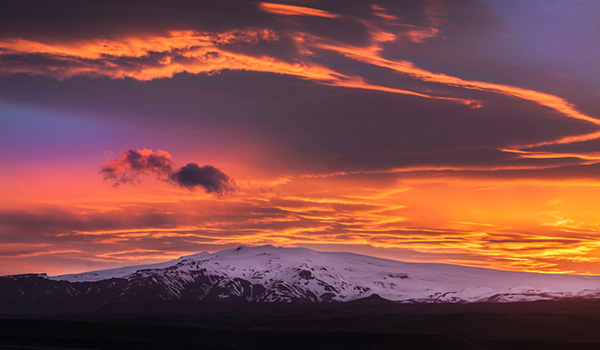
With 11% of the country covered in glacial ice, it’s hard to take a trip to Iceland and not catch a glimpse of these geological wonders. But, if you want to get your feet onto a glacier, there are a bunch of activities you can do. Reykjavik Excursions have a variety of glacier and ice cave tours so you can make the most of your time in Iceland.
Classic tours such as the highlights of the Golden Circle and wonders of the south coast will often include a stop to admire Iceland’s glaciers from a distance and see how they cut through the volcanic landscape while snapping a picture or two.
For a more in-depth glacial experience, you can embark on a glacier hike. With a local guide ensuring you don’t step into a hidden sinkhole or fall down an icy ravine, try one of Reykjavik Excursion’s glacier hiking tours which has crampons and pickaxes included.
If walking and hiking isn’t your thing, perhaps a snowmobile session on a glacier is what you’re after. Have your James Bond moment, sailing across the pristine white snow and sleek icy world and perhaps stop to explore an ice cave along the way.
You can also admire Iceland’s glacial landscape from the deck of a boat with an amphibious cruise on Jökulsárlón lagoon where glowing blue icebergs float in the sea and a huge glacier looms in the background.
Can I walk on glaciers in Iceland?
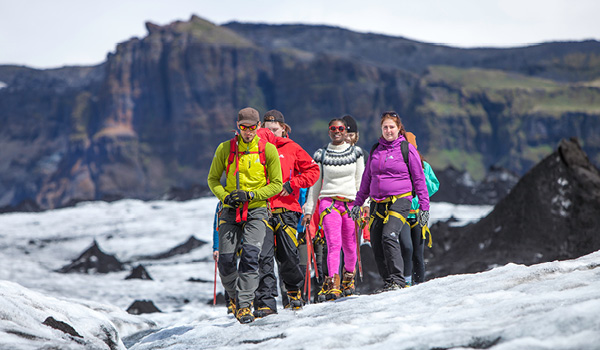
One of the best ways to experience Iceland’s glaciers is by firmly getting your feet on the ice with a glacier hike. Walking on the glaciers is a fun activity, but you should be fully equipped for it with crampons for your shoes, proper waterproof hiking boots, a waterproof jacket and lots of layers. A pickaxe and walking poles are also a good idea for any glacier hike. Guided glacier hikes can take all the hassle out of this for you, and a guide can ensure you don’t fall down a hidden hole in the ice and that you stick to the sturdiest path across the glacier.
Which is the closest glacier to Reykjavik?
Langjökull is the closest glacier to Reykjavik in Iceland. Here, you can embark on a snowmobile tour, or simply admire it from Haukadalur Valley on the Golden Circle. Húsafell is the main access point to the glacier, where most of the glacier tours depart and it is 130 kilometres from Reykjavik. So it takes around an hour and a half to drive from the capital to Langjökull.
Glacier Lagoons in Iceland
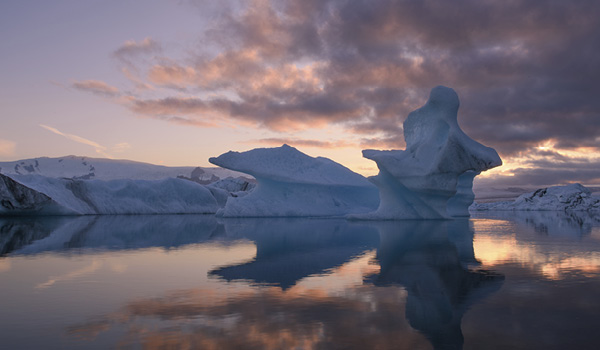
One of Iceland’s most photogenic and enthralling spots is the Jökulsárlón Glacier Lagoon, where glowing blue icebergs float serenely on the water. Here, you can take an amphibious cruise through this pristine Arctic scenery and get close enough to touch the freezing blocks of ice. Glacier lagoons are formed by glacial meltwater, which is usually crystal-clear and fresh.
Jökulsárlón isn’t the only glacial lagoon in Iceland, though it is probably the most popular. Fjallsárlón Glacier Lagoon lies on the southern side of Vatnajokull glacier, and Zodiac cruises to the lesser-known lagoon leave from the site at Jökulsárlón.
Glacier tours in Iceland
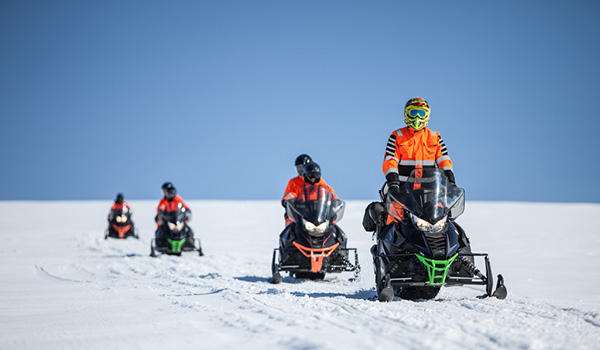
Reykjavik Excursions offers a wide range of glacier tours in Iceland. Joining a glacier tour leaving from Reykjavik means you don’t have to worry about the long drive to the south coast, and can join a guided glacier walk with a professional guide.
The most popular way to experience Iceland’s glaciers, is to embark on a hike with a guide. The south coast and glacier hiking tour takes you onto the vast, icy expanse of Sólheimajökull for an invigorating hike, guided to avoid the sink holes and ravines that can form in the moving ice. This tour also stops at two beautiful waterfalls, Skógafoss and Seljalandsfoss.
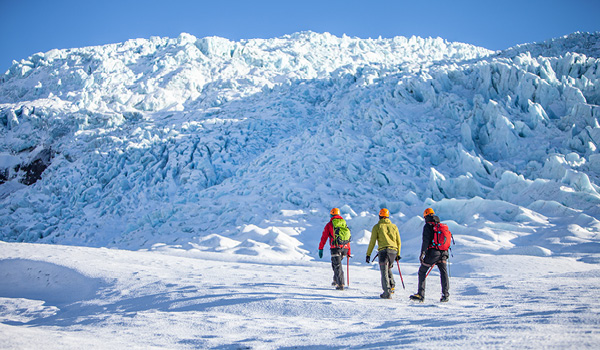
Those that enjoy a little adrenaline rush and don’t fancy walking but want to set foot on a glacier should opt for a tour that includes a snowmobiling session. The Golden Circle and glacier snowmobiling tour combines the iconic natural wonders of the Golden Circle with a snowmobiling session on the white expanse of Langjökull glacier. While the south coast and glacier snowmobiling adventure is an option for those that would rather pair their snowmobiling session with the waterfalls and black-sand beaches of the south coast. If you want to get straight to the action, there’s a “meet on location” option with the Snowmobile Tour of Mýrdalsjökull Glacier, where you can head straight to the snowmobile station yourself to start your adventure.
For something a little different, perhaps opt for the Golden Circle and Langjökull Monster Truck which combines the waterfalls and geysers of the Golden Circle with a thrilling trip in a huge monster truck across the icy expanse of Langjӧkull glacier.
Photographers and hikers alike should consider a tour that combines a glacier hike with a trip into an ice cave. On our partners' Aurora Ice Cave Tour, meeting on location at Jökulsárlón Glacier Lagoon, you can explore the sleek Arctic world of Breiðamerkurjökull glacier. You’ll hike across the glacier before exploring a natural ice cave that feels as though it’s made of cut diamond. Another “meet on location” option is the Blue Ice Experience, where a guide will meet you at Skaftafell to traverse across the ice ridges of Falljökull and spot ice sculptures. If you're up for a more challenging tour, this one in Skaftafell comes highly recommended for the brave.
Closer to Reykjavik, you can join the Langjökull ice cave experience to discover a man-made ice cavern. This ice cave has the benefit of being open year-round, rather than just in the autumn and winter months like Iceland’s natural ice caves.
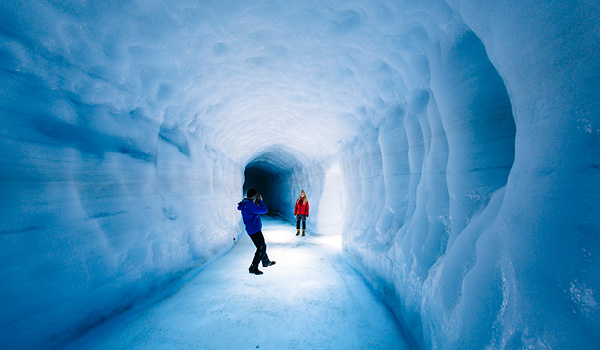
One of the most iconic Icelandic things you can do is admire the white tongue of Vantnajokull glacier from the serene waters of the Jökulsárlón Glacier Lagoon. Embarking on a boat tour means you can admire the drifting icebergs and immerse yourself completely in the Arctic landscape. Jökulsárlón is a long drive from Reykjavik and can feel somewhat rushed in a big group, so opting for a private tour of the Jökulsárlón Glacier Lagoon means you can enjoy the sights of the south coast at your own pace.
Overall, Reykjavik Excursions have a huge selection of ways to explore Iceland’s glaciers. Whether you are looking for an adrenaline-fuelled snowmobiling ride, a brisk hike, or want to discover the beautiful ice caves.
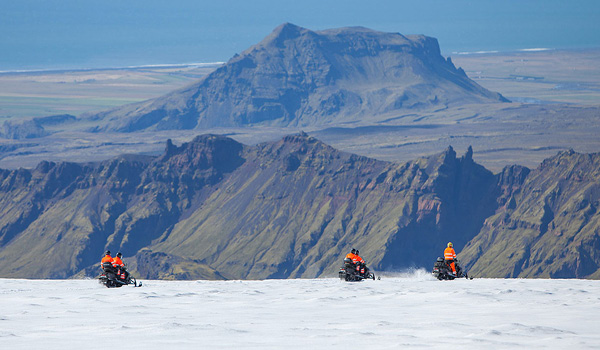
Now that you are clued up on all things glacial in Iceland, it’s time to start booking the perfect glacier experience for you. A guided hike means you can get up close and personal with Iceland’s glacial landscape, with the added bonus of a professional guide leading the way. Heading out by snowmobile can save your legs and still reward with stunning view of the country’s volcanic landscape from the top of an ice sheet. Stopping to explore an ice cave makes for the perfect photo opportunity and lets you experience the sleek Arctic world of films and TV. While simply admiring the white tongue of a glacier from the deck of a boat in the Jökulsárlón Glacier Lagoon is often the highlight of any trip to Iceland.
Blogg
Fáðu innblástur! Upplýsingar og góð ráð, áhugaverðir áfangastaðir, skemmtilegar staðreyndar og margt fleira. Bloggið okkar er á ensku en það er stórskemmtilegt engu að síður!
The Silver Circle of West Iceland - Your Guide
You’ve heard of the Golden Circle, but here’s why you should head to Iceland’s western region to explore the msytical Silver Circle tour route.
Lesa bloggIceland’s glaciers - your ultimate guide
22. júlí 2022
Iceland’s glaciers - your ultimate guide
22. júlí 2022
An old joke says Iceland is green and Greenland is covered in ice. But a huge section of Iceland’s landmass is covered in glacial ice. Flopping like great white tongues through mountain ravines and stretching across volcanoes, Iceland’s glaciers are a sight to behold, either from a roadside lookout point, from the seat of a snowmobile or by embarking on a glacial hike. Glacier tours in Iceland let you get up close and personal with these magnificent geological wonders and a guided tour means you can learn about their creation and history. You can even experience the ethereal blue world of a glacial ice cave. However you want to discover glaciers in Iceland, Reykjavik Excursions has a range of tours to suit all kinds of traveller, and we’ve got the ultimate guide to Iceland’s glaciers to prepare you.
What is a glacier?
Glaciers are created over thousands of years as fallen snow turns into a huge mass of ice, usually in the valley of a mountain or (often in Iceland’s case) volcano. You may not be able to see it, but glaciers actually move. They inch very very slowly forward, like a super slow-motion river. You might hear cracks and creaks as the mass of ice shapeshifts, creating holes and crevasses, and even beautiful ice caves.
Most of the world’s glaciers are found in the Arctic regions and were formed in the last Ice Age. Iceland’s volcanic landscape is plugged with these glaciers and ice caps, which you can easily explore in person. How many glaciers are in Iceland? There are precisely 269 named glaciers in Iceland, which is a lot for such a small land mass. Altogether, Iceland’s glaciers make up about 11% of the entire country. Vatnajökull is an ice cap atop a volcano and is the largest glacial area in Iceland. It was awarded National Park status in 2008 and covers a whopping 4,141 square kilometres (about 14% of Iceland).
How old are glaciers in Iceland?
Some of Iceland’s glaciers were first formed thousands of years ago. Take Vatnajökull for example, which was formed 2,500 years ago. The ice started out as a cap on top of a volcano, and it wasn’t until the 13th century that the ice started to expand before culminating in the huge mass of glacier it is today in the 19th century.
Between 1890 and 1920, Iceland saw its own mini-Ice Age when glaciers expanded rapidly, before retreating as the climate warmed in the 1930s. Then, another cool period in the 1960s allowed Iceland’s glaciers to expand again, before another warming in the 1980s. So you can see Iceland’s glaciers wax and wane like the moon, depending on the climate.
Where are glaciers in Iceland?

Iceland’s most famous glacier is probably Vatnajökull. It stretches over around 8,300 square kilometres and is around 900 metres at its thickest point. It’s the largest glacier in Iceland (and Europe in fact) and can be found in the southeast of the island. Huge white tongues spill through the mountain valleys from a central point and each of these off-shoots has been named. The most famous tongues are probably Öræfajökull, sitting atop the Öræfajökull volcano, and Svínafellsjökull which is a popular spot for glacier hiking as it’s close to Skaftafell. Svínafellsjökull has been used as a filming location for Interstellar and Batman Begins.
The second biggest glacier in Iceland is Langjökull, which literally means “long glacier”. In the heart of the Golden Circle tour circuit, this is a popular place to visit for snowmobiling. It’s about 50 kilometres long and around 580 metres deep at its thickest point. One of Langjökull’s biggest pulls is that it contains a manmade ice cave, which is accessible all year round, even when most other ice caves are closed in summer.
Famous for a completely different reason, the Eyjafjallajökull glacier can be spotted from the ring road around Iceland. It’s quite small, but no less impressive. Perhaps the most memorable thing about Eyjafjallajökull is the volcanic eruption in 2010 which caused an ash cloud and grounded thousands of planes across the world. You can spot this glacier from the roadside, or embark on a snowmobiling tour or 4x4 adventure if you want to get closer.
How to see glaciers in Iceland?

With 11% of the country covered in glacial ice, it’s hard to take a trip to Iceland and not catch a glimpse of these geological wonders. But, if you want to get your feet onto a glacier, there are a bunch of activities you can do. Reykjavik Excursions have a variety of glacier and ice cave tours so you can make the most of your time in Iceland.
Classic tours such as the highlights of the Golden Circle and wonders of the south coast will often include a stop to admire Iceland’s glaciers from a distance and see how they cut through the volcanic landscape while snapping a picture or two.
For a more in-depth glacial experience, you can embark on a glacier hike. With a local guide ensuring you don’t step into a hidden sinkhole or fall down an icy ravine, try one of Reykjavik Excursion’s glacier hiking tours which has crampons and pickaxes included.
If walking and hiking isn’t your thing, perhaps a snowmobile session on a glacier is what you’re after. Have your James Bond moment, sailing across the pristine white snow and sleek icy world and perhaps stop to explore an ice cave along the way.
You can also admire Iceland’s glacial landscape from the deck of a boat with an amphibious cruise on Jökulsárlón lagoon where glowing blue icebergs float in the sea and a huge glacier looms in the background.
Can I walk on glaciers in Iceland?

One of the best ways to experience Iceland’s glaciers is by firmly getting your feet on the ice with a glacier hike. Walking on the glaciers is a fun activity, but you should be fully equipped for it with crampons for your shoes, proper waterproof hiking boots, a waterproof jacket and lots of layers. A pickaxe and walking poles are also a good idea for any glacier hike. Guided glacier hikes can take all the hassle out of this for you, and a guide can ensure you don’t fall down a hidden hole in the ice and that you stick to the sturdiest path across the glacier.
Which is the closest glacier to Reykjavik?
Langjökull is the closest glacier to Reykjavik in Iceland. Here, you can embark on a snowmobile tour, or simply admire it from Haukadalur Valley on the Golden Circle. Húsafell is the main access point to the glacier, where most of the glacier tours depart and it is 130 kilometres from Reykjavik. So it takes around an hour and a half to drive from the capital to Langjökull.
Glacier Lagoons in Iceland

One of Iceland’s most photogenic and enthralling spots is the Jökulsárlón Glacier Lagoon, where glowing blue icebergs float serenely on the water. Here, you can take an amphibious cruise through this pristine Arctic scenery and get close enough to touch the freezing blocks of ice. Glacier lagoons are formed by glacial meltwater, which is usually crystal-clear and fresh.
Jökulsárlón isn’t the only glacial lagoon in Iceland, though it is probably the most popular. Fjallsárlón Glacier Lagoon lies on the southern side of Vatnajokull glacier, and Zodiac cruises to the lesser-known lagoon leave from the site at Jökulsárlón.
Glacier tours in Iceland

Reykjavik Excursions offers a wide range of glacier tours in Iceland. Joining a glacier tour leaving from Reykjavik means you don’t have to worry about the long drive to the south coast, and can join a guided glacier walk with a professional guide.
The most popular way to experience Iceland’s glaciers, is to embark on a hike with a guide. The south coast and glacier hiking tour takes you onto the vast, icy expanse of Sólheimajökull for an invigorating hike, guided to avoid the sink holes and ravines that can form in the moving ice. This tour also stops at two beautiful waterfalls, Skógafoss and Seljalandsfoss.

Those that enjoy a little adrenaline rush and don’t fancy walking but want to set foot on a glacier should opt for a tour that includes a snowmobiling session. The Golden Circle and glacier snowmobiling tour combines the iconic natural wonders of the Golden Circle with a snowmobiling session on the white expanse of Langjökull glacier. While the south coast and glacier snowmobiling adventure is an option for those that would rather pair their snowmobiling session with the waterfalls and black-sand beaches of the south coast. If you want to get straight to the action, there’s a “meet on location” option with the Snowmobile Tour of Mýrdalsjökull Glacier, where you can head straight to the snowmobile station yourself to start your adventure.
For something a little different, perhaps opt for the Golden Circle and Langjökull Monster Truck which combines the waterfalls and geysers of the Golden Circle with a thrilling trip in a huge monster truck across the icy expanse of Langjӧkull glacier.
Photographers and hikers alike should consider a tour that combines a glacier hike with a trip into an ice cave. On our partners' Aurora Ice Cave Tour, meeting on location at Jökulsárlón Glacier Lagoon, you can explore the sleek Arctic world of Breiðamerkurjökull glacier. You’ll hike across the glacier before exploring a natural ice cave that feels as though it’s made of cut diamond. Another “meet on location” option is the Blue Ice Experience, where a guide will meet you at Skaftafell to traverse across the ice ridges of Falljökull and spot ice sculptures. If you're up for a more challenging tour, this one in Skaftafell comes highly recommended for the brave.
Closer to Reykjavik, you can join the Langjökull ice cave experience to discover a man-made ice cavern. This ice cave has the benefit of being open year-round, rather than just in the autumn and winter months like Iceland’s natural ice caves.

One of the most iconic Icelandic things you can do is admire the white tongue of Vantnajokull glacier from the serene waters of the Jökulsárlón Glacier Lagoon. Embarking on a boat tour means you can admire the drifting icebergs and immerse yourself completely in the Arctic landscape. Jökulsárlón is a long drive from Reykjavik and can feel somewhat rushed in a big group, so opting for a private tour of the Jökulsárlón Glacier Lagoon means you can enjoy the sights of the south coast at your own pace.
Overall, Reykjavik Excursions have a huge selection of ways to explore Iceland’s glaciers. Whether you are looking for an adrenaline-fuelled snowmobiling ride, a brisk hike, or want to discover the beautiful ice caves.

Now that you are clued up on all things glacial in Iceland, it’s time to start booking the perfect glacier experience for you. A guided hike means you can get up close and personal with Iceland’s glacial landscape, with the added bonus of a professional guide leading the way. Heading out by snowmobile can save your legs and still reward with stunning view of the country’s volcanic landscape from the top of an ice sheet. Stopping to explore an ice cave makes for the perfect photo opportunity and lets you experience the sleek Arctic world of films and TV. While simply admiring the white tongue of a glacier from the deck of a boat in the Jökulsárlón Glacier Lagoon is often the highlight of any trip to Iceland.
Blogg
Fáðu innblástur! Upplýsingar og góð ráð, áhugaverðir áfangastaðir, skemmtilegar staðreyndar og margt fleira. Bloggið okkar er á ensku en það er stórskemmtilegt engu að síður!
The Silver Circle of West Iceland - Your Guide
You’ve heard of the Golden Circle, but here’s why you should head to Iceland’s western region to explore the msytical Silver Circle tour route.
Lesa blogg